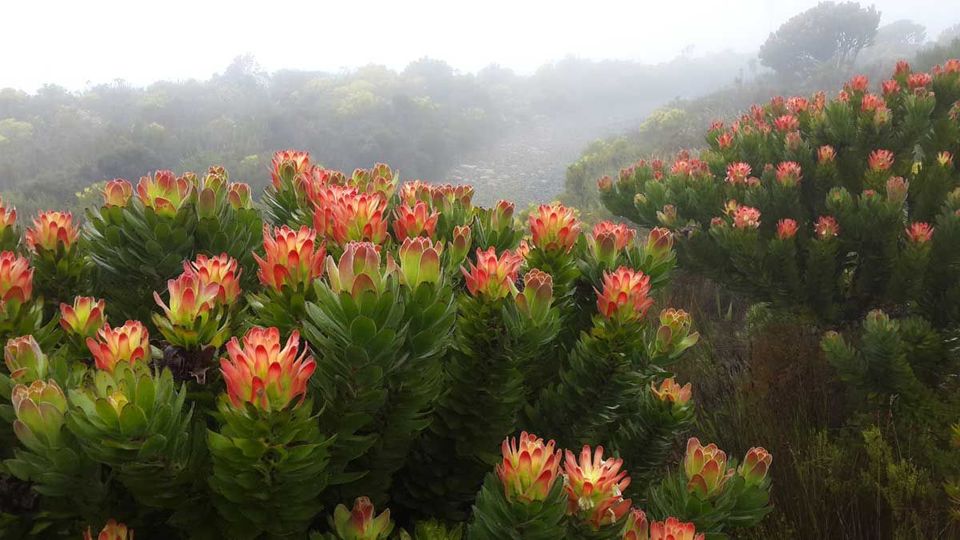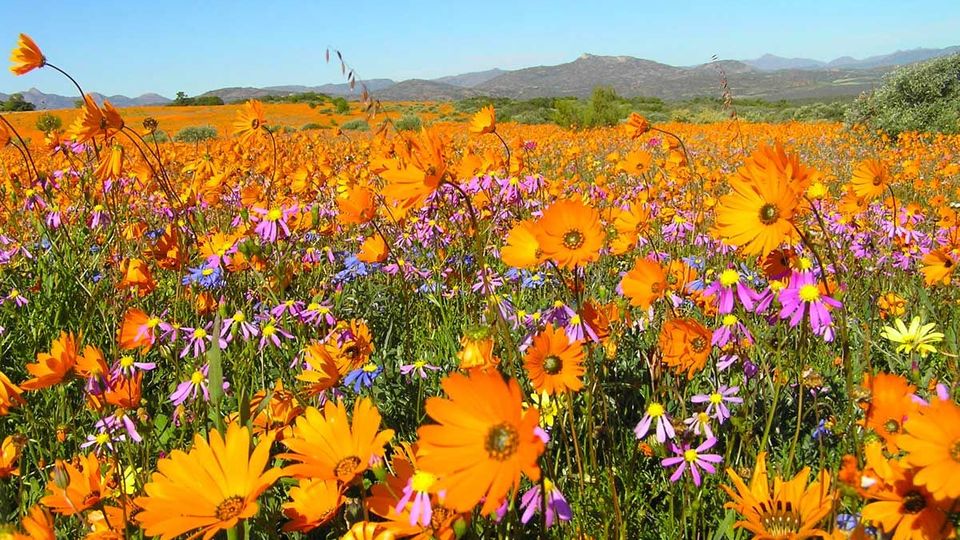
South Africa is famous for its bush and beaches, but there is so much more to see, particularly for visitors who have a fondness for flowers or who delight in nature. The country is marvellously botanically diverse and offers an extraordinary array of plant species, many of them unique to South Africa.
The Cape Floral Kingdom
The Cape Floristic Kingdom is one of only six floral kingdoms in the world, and the only one that occurs entirely in one country. There are more than 9000 known species of vascular plants, with a large proportion of its diversity down to its flowering fynbos (meaning ‘fine bush’ in Dutch). Fynbos bushes come with their own spectacular variety from the magnificent King Protea, to the red and yellow Pincushion Proteas, to the Bright Ericas (heathers), irises and delicate wild orchids – and the birds, insects, reptiles and small animals that live amongst them.

A trip to Kirstenbosch Botanical Gardens is a must for any visitor – and even if you aren’t green-fingered, you’ll still appreciate the grandeur of the setting on the slopes of Table Mountain. There’s a protea garden, a fragrance garden, a medicinal garden and a cycad amphitheatre. A striking wooden walkway winds over the garden at canopy level, giving visitors a birds’ eye view (and a great photo op).
If you are a hiker, or feel like exploring a little further afield, try Silvermine Nature Reserve on the Tokai side of Table Mountain or Cape Point. They are both wonderful in their own right, and good places to experience the fynbos up close. For an indulgent few days of nature exploration, whale watching, and other outdoor pursuits in peaceful pristine wilderness, you can head to the Gansbaai area and Grootbos Private Nature Reserve, or a rustic few days of hiking on the Fynbos Trail.
Spring flowers

A particular treat for flower-lovers is the spectacular flower season that blankets the nature reserves of the Western and Northern Cape from August to late September.
The semi-desert of Namaqualand in the Northern Cape comes alive in spring time, when its gentle hills are covered in a carpet of colourful daisies and other flowers. Tours are available, or you can self-drive (the area is a five or six-hour drive North of Cape Town).
Close enough for a day or overnight trip from the city, and also lovely for spring flowers, is the West Coast National Park. You can hike, bike or drive around the park with its flowers, blue lagoon and sand dunes.
Trees, please
South Africa is home to some distinctive and iconic trees. The baobab is so unusual in its shape that legend has it that the gods planted it upside down with its roots showing. These trees live a long time and grow to a massive size – so wide that old examples have been hollowed out to serve as shelters and even pubs. You can see them in Limpopo Province, which makes it easy to combine baobab viewing with a bush holiday in the Kruger Park.
The quiver tree or kokerboom is a spectacular, sculptural aloe with smooth branches ending in rosettes of blue-green leaves and, in winter, yellow flowers. See them in the Northern Cape, near Upington, and in the Augrabies Falls National Park. There’s even a quiver tree forest at the village of Nieuwoudtville.
More accessible for most, is the Karoo Desert National Botanical Gardens, 80km from Cape Town. The endangered giant quiver tree can be seen in the Ai-Ais Richtersveld Transfrontier Park.
Purple rain
In October, the famous jacaranda trees lining the streets of the cities and suburbs of Pretoria and Johannesburg come into bloom and scatter their blossoms onto the streets. The trees are not indigenous, Jacaranda mimosifolia was introduced from Brazil in 1829, but they are a source of pride and delight to residents, and have become a drawcard for tourists from around the world.
An excellent way to appreciate the trees in Johannesburg is to head for one of the city’s ridges, in the suburbs of Houghton, Observatory or Melville. The Four Seasons Westcliff Hotel on the Westcliff Ridge is a super cool spot for cocktails and jacaranda viewing, overlooking the Johannesburg Zoo and the leafy northern suburbs.
In Pretoria, a good viewing spot is the Union Buildings, which you can get to from Johannesburg via the Gautrain.
